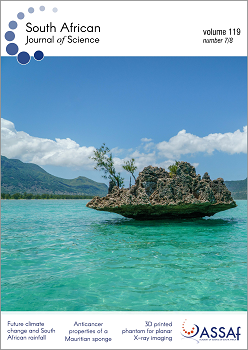Binary and ternary metals adsorption from greywater using spent green tea as a novel adsorbent
DOI:
https://doi.org/10.17159/sajs.2023/13352Keywords:
adsorption, binary system, greywater, mercury, green teaAbstract
Adsorption is one of the most easy-to-operate, less costly, efficient and, most importantly, environmentally friendly methods of removing toxic metals from aqueous environments. We used spent Impra Green Tea Ginseng Flavoured to recover mercury (Hg2+), lead (Pb2+) and cadmium (Cd2+) in binary and ternary systems from greywater. We undertook this study in binary and ternary systems at adsorbent dosages with a corresponding 100 mL varied initial metal concentrations of the greywater. The adsorption efficiency at varied concentrations and dosages in the binary systems by the spent tea waste ranged from 38.5% to 100% for lead, 11.50% to 100% for cadmium and was 100% for mercury. In the ternary system, the adsorption efficiency of toxic metals ranged from 28.91% to 72.85% for cadmium and was 100% for mercury and lead. The maximum adsorption capacity (Qe) for toxic metals in the binary system ranged from 38.46 to 81.97 mg/g for Pb2+ and 12.64 to 56.82 mg/g for Cd2+. The Langmuir adsorption isotherm model was the best fit for the adsorption of toxic metals by Impra Green Tea Ginseng Flavoured. The pH under which the experiments were conducted showed very high removal efficiency for lead and mercury but lower removal efficiencies for cadmium. Spent Impra Green Tea Ginseng Flavoured can be used as an effective and low-cost adsorbent of toxic metals from greywater or wastewater. Based on our findings, further studies should be conducted to determine the effects of varying the contact time, temperature and elevated metal concentrations in the greywater or other wastewater.
Significance:
- This study provides useful information on how spent Impra Green Tea Ginseng Flavoured can be used as an effective and low-cost adsorbent of toxic metals from greywater or wastewater.
Published
Issue
Section
License

All articles are published under a Creative Commons Attribution 4.0 International Licence
Copyright is retained by the authors. Readers are welcome to reproduce, share and adapt the content without permission provided the source is attributed.
Disclaimer: The publisher and editors accept no responsibility for statements made by the authors
How to Cite
- Abstract 278
- PDF 389
- EPUB 81
- XML 92












.png)